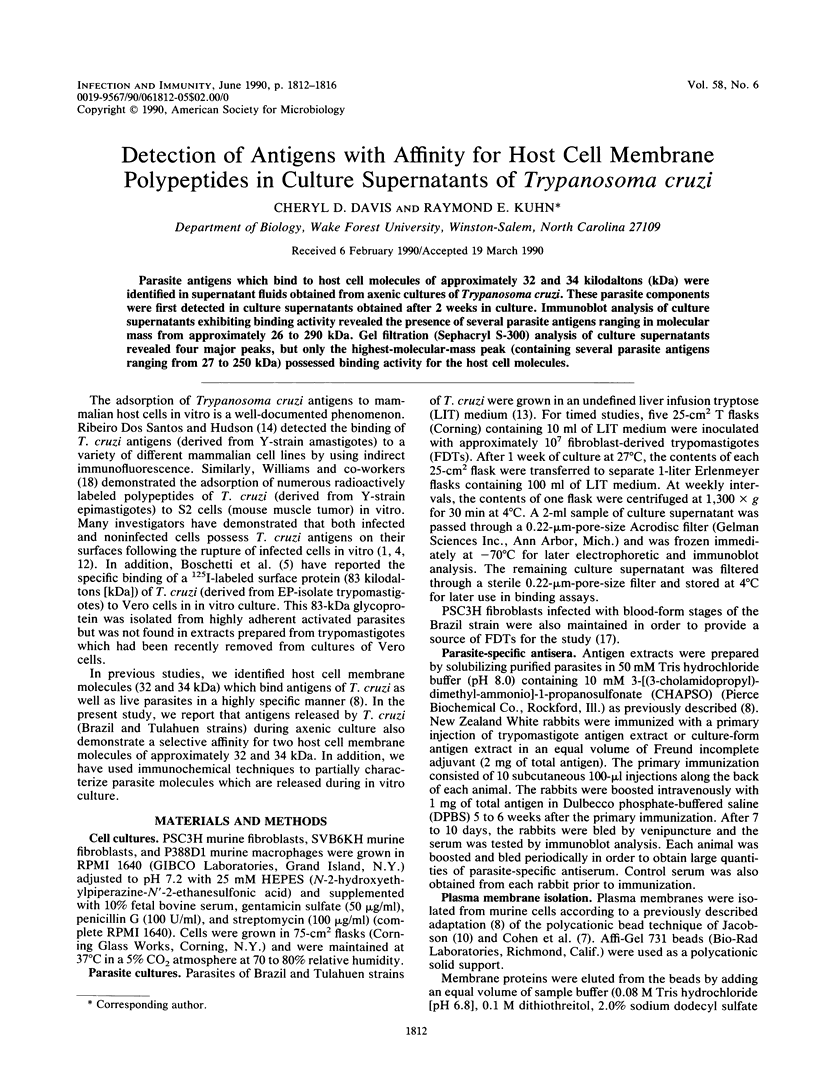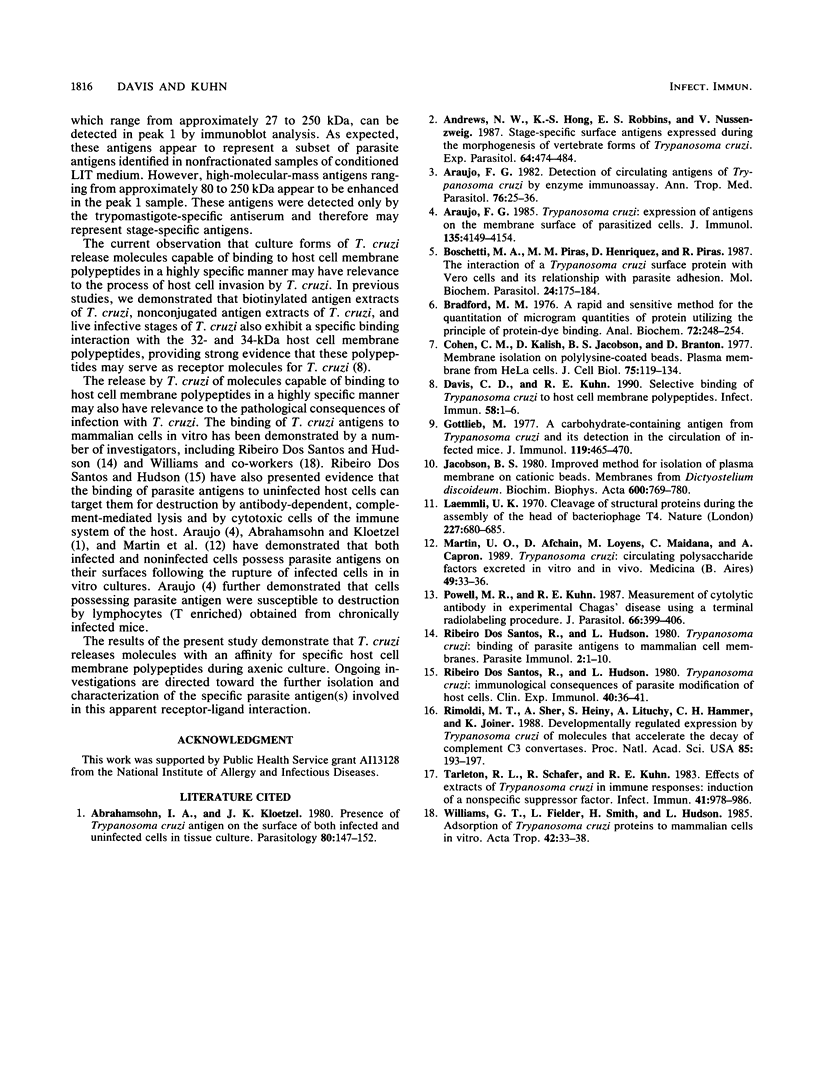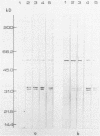Abstract
Parasite antigens which bind to host cell molecules of approximately 32 and 34 kilodaltons (kDa) were identified in supernatant fluids obtained from axenic cultures of Trypanosoma cruzi. These parasite components were first detected in culture supernatants obtained after 2 weeks in culture. Immunoblot analysis of culture supernatants exhibiting binding activity revealed the presence of several parasite antigens ranging in molecular mass from approximately 26 to 290 kDa. Gel filtration (Sephacryl S-300) analysis of culture supernatants revealed four major peaks, but only the highest-molecular-mass peak (containing several parasite antigens ranging from 27 to 250 kDa) possessed binding activity for the host cell molecules.
Full text
PDF




Images in this article
Selected References
These references are in PubMed. This may not be the complete list of references from this article.
- Abrahamsohn I. A., Kloetzel J. K. Presence of Trypanosoma cruzi antigen on the surface of both infected and uninfected cells in tissue culture. Parasitology. 1980 Feb;80(1):147–152. doi: 10.1017/s0031182000000603. [DOI] [PubMed] [Google Scholar]
- Andrews N. W., Hong K. S., Robbins E. S., Nussenzweig V. Stage-specific surface antigens expressed during the morphogenesis of vertebrate forms of Trypanosoma cruzi. Exp Parasitol. 1987 Dec;64(3):474–484. doi: 10.1016/0014-4894(87)90062-2. [DOI] [PubMed] [Google Scholar]
- Araujo F. G. Detection of circulating antigens of Trypanosoma cruzi by enzyme immunoassay. Ann Trop Med Parasitol. 1982 Feb;76(1):25–36. doi: 10.1080/00034983.1982.11687501. [DOI] [PubMed] [Google Scholar]
- Araujo F. G. Trypanosoma cruzi: expression of antigens on the membrane surface of parasitized cells. J Immunol. 1985 Dec;135(6):4149–4154. [PubMed] [Google Scholar]
- Boschetti M. A., Piras M. M., Henríquez D., Piras R. The interaction of a Trypanosoma cruzi surface protein with Vero cells and its relationship with parasite adhesion. Mol Biochem Parasitol. 1987 Jun;24(2):175–184. doi: 10.1016/0166-6851(87)90104-6. [DOI] [PubMed] [Google Scholar]
- Bradford M. M. A rapid and sensitive method for the quantitation of microgram quantities of protein utilizing the principle of protein-dye binding. Anal Biochem. 1976 May 7;72:248–254. doi: 10.1006/abio.1976.9999. [DOI] [PubMed] [Google Scholar]
- Cohen C. M., Kalish D. I., Jacobson B. S., Branton D. Membrane isolation on polylysine-coated beads. Plasma membrane from HeLa cells. J Cell Biol. 1977 Oct;75(1):119–134. doi: 10.1083/jcb.75.1.119. [DOI] [PMC free article] [PubMed] [Google Scholar]
- Davis C. D., Kuhn R. E. Selective binding of Trypanosoma cruzi to host cell membrane polypeptides. Infect Immun. 1990 Jan;58(1):1–6. doi: 10.1128/iai.58.1.1-6.1990. [DOI] [PMC free article] [PubMed] [Google Scholar]
- Gottlieb M. A carbohydrate-containing antigen from Trypanosoma cruzi and its detection in the circulation of infected mice. J Immunol. 1977 Aug;119(2):465–470. [PubMed] [Google Scholar]
- Jacobson B. S. Imporved method for isolation of plasma membrane on cationic beads. Membranes from Dictyostelium discoideum. Biochim Biophys Acta. 1980 Aug 14;600(3):769–780. doi: 10.1016/0005-2736(80)90479-4. [DOI] [PubMed] [Google Scholar]
- Laemmli U. K. Cleavage of structural proteins during the assembly of the head of bacteriophage T4. Nature. 1970 Aug 15;227(5259):680–685. doi: 10.1038/227680a0. [DOI] [PubMed] [Google Scholar]
- Martín U. O., Afchain D., Loyens M., Maidana C., Caprón A. Trypanosoma cruzi: circulating polysaccharide factors excreted in vitro and in vivo. Medicina (B Aires) 1989;49(1):33–36. [PubMed] [Google Scholar]
- Powell M. R., Kuhn R. E. Measurement of cytolytic antibody in experimental Chagas' disease using a terminal radiolabelling procedure. J Parasitol. 1980 Jun;66(3):399–406. [PubMed] [Google Scholar]
- Ribeiro Dos Santos R., Hudson L. Trypanosoma cruzi: immunological consequences of parasite modification of host cells. Clin Exp Immunol. 1980 Apr;40(1):36–41. [PMC free article] [PubMed] [Google Scholar]
- Rimoldi M. T., Sher A., Heiny S., Lituchy A., Hammer C. H., Joiner K. Developmentally regulated expression by Trypanosoma cruzi of molecules that accelerate the decay of complement C3 convertases. Proc Natl Acad Sci U S A. 1988 Jan;85(1):193–197. doi: 10.1073/pnas.85.1.193. [DOI] [PMC free article] [PubMed] [Google Scholar]
- Tarleton R. L., Schafer R., Kuhn R. E. Effects of extracts of Trypanosoma cruzi on immune responses: induction of a nonspecific suppressor factor. Infect Immun. 1983 Sep;41(3):978–986. doi: 10.1128/iai.41.3.978-986.1983. [DOI] [PMC free article] [PubMed] [Google Scholar]
- Williams G. T., Fielder L., Smith H., Hudson L. Adsorption of Trypanosoma cruzi proteins to mammalian cells in vitro. Acta Trop. 1985 Mar;42(1):33–38. [PubMed] [Google Scholar]







